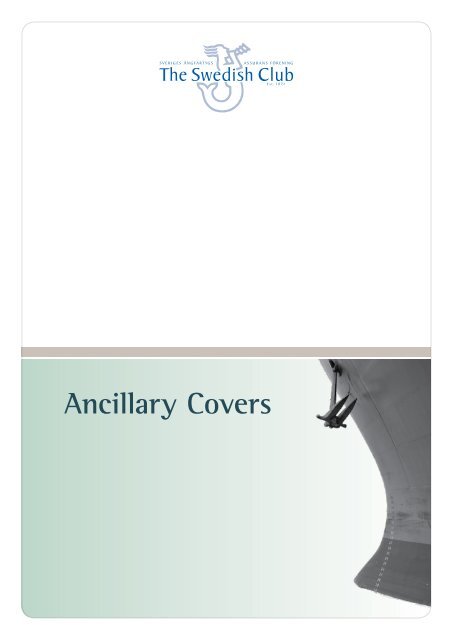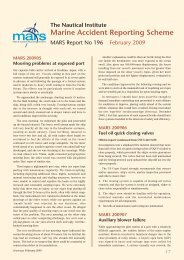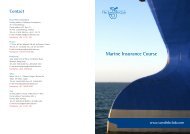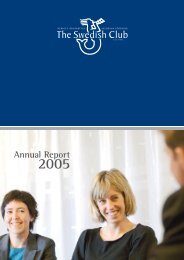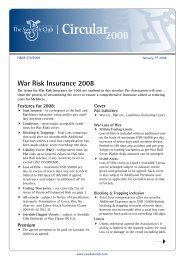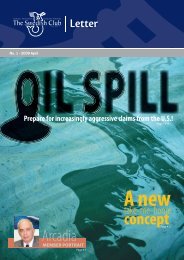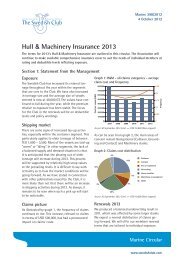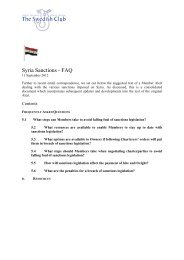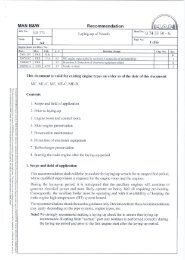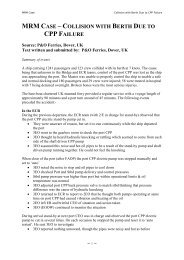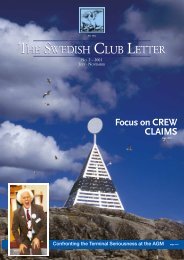All Ancillary Covers in one PDF - The Swedish Club
All Ancillary Covers in one PDF - The Swedish Club
All Ancillary Covers in one PDF - The Swedish Club
Create successful ePaper yourself
Turn your PDF publications into a flip-book with our unique Google optimized e-Paper software.
<strong>Ancillary</strong> <strong>Covers</strong>
Charterer’s InterestNarrativeA charterer - normally a time charterer - may have a further <strong>in</strong>terest <strong>in</strong> the chartered vessel. For example, theship may be sub-let on a time charter or the charterer may have a purchase option. This <strong>in</strong>terest is <strong>in</strong>surable.DescriptionCharterers commonly charter ships either on a voyage or time charter basis. Primarily <strong>in</strong> the latter circumstances,the chartered vessel represents future <strong>in</strong>come. Naturally, should the ship be lost, the charterer will not paycharter hire, but he may f<strong>in</strong>d it hard to secure a replacement vessel either at the same rate or a ship so suited tothe <strong>in</strong>tended trade. As a result, the charterer may not earn the future freight, as anticipated.In order to cover this exposure, the charterer can protect himself by a total loss <strong>in</strong>surance known as Charterer’sInterest. Should the chartered ship become a total loss, the charterer will be <strong>in</strong>demnified by this cover.As there is no entitlement to earn m<strong>one</strong>y on <strong>in</strong>surance, but rather only to make good losses - this cover isoften provided on a reduc<strong>in</strong>g basis. For example, if the charterer anticipates a profit of USD 1.2 million on thevessel dur<strong>in</strong>g a charter period of, say, <strong>one</strong> year, his <strong>in</strong>terest when the charter is signed will be that sum. After<strong>one</strong> month, however, he has earned USD 100,000 and, therefore, his <strong>in</strong>surable <strong>in</strong>terest at the start of thesecond month is reduced to USD 1.1 million. This cover is often written on a daily reduc<strong>in</strong>g basis. On the lastday of cover, where there is no future profit at risk, the <strong>in</strong>sured amount is at zero.This note is a general description of Charterer’s Interest <strong>in</strong>surance. For more detailed <strong>in</strong>formation, pleaserefer to the slip or Certificate of Entry.ConditionsThis cover is based on Charterer’s Interest on Increased Value, Total Loss Only.••This <strong>in</strong>surance is subject to the Institute Time Clauses Hulls, Increased Value (<strong>in</strong>clud<strong>in</strong>g Excess Liabilities)Total Loss Only - Time 1/10/83, to be <strong>in</strong>terpreted accord<strong>in</strong>g to <strong>Swedish</strong> Law with arbitration <strong>in</strong> Gothenburg,as per Arbitration Clause Gothenburg (B.1.1). Amended to Total Loss Only.••<strong>The</strong> Articles of Association and current circulars.••Radioactive Contam<strong>in</strong>ation, Chemical, Biological, Biochemical and Electromagnetic Weapons ExclusionClause C.1.3 (LSW 370, 2003-11-10).••Institute Cyber Attack Exclusion Clause C.1.3.1 (LSW 380, 2003-11-10).••Conditions for Hull and Mach<strong>in</strong>ery, where applicable.••Cancellation returns only.••Warranted not <strong>in</strong>clud<strong>in</strong>g War, terrorism or similar risks be<strong>in</strong>g available under ord<strong>in</strong>ary War Risks covers.••Reduc<strong>in</strong>g: the <strong>in</strong>sured amount <strong>in</strong> this policy reduces by USD (amount) per day/month from date of<strong>in</strong>ception.••Premiums and rates are calculated on the <strong>in</strong>sured amount at <strong>in</strong>ception of the policy.••Premiums are payable quarterly <strong>in</strong> advance, 1 January, 1 April, 1 July and 1 October. Delay <strong>in</strong> paymentmay render cancellation of cover and <strong>in</strong>terest on delay, as per Rules of the Association.••War <strong>in</strong>cluded, if agreed.7www.swedishclub.comVers. 2/sept/2007
Charterer’s <strong>All</strong> Inclusive CoverNarrativeA person or a company act<strong>in</strong>g as charterer of a ship assumes responsibilities broadly similar to those of anowner. <strong>The</strong> contract<strong>in</strong>g parties - normally a cargo owner or sub-charterer - will view the charterer as the“owner” of the ship. <strong>The</strong> charterer also assumes liabilities towards the vessel owner, <strong>in</strong>clud<strong>in</strong>g damage <strong>in</strong>flictedon the ship.In addition a charterer - normally a time charterer - may have a further <strong>in</strong>terest <strong>in</strong> the chartered vessel. Forexample, the ship may be sub-let on a time charter or the charterer may have a purchase option. This <strong>in</strong>terestis <strong>in</strong>surable.F<strong>in</strong>ally, the charterer may have an <strong>in</strong>surable <strong>in</strong>terest if the chartered ship susta<strong>in</strong>s damage result<strong>in</strong>g <strong>in</strong> aparticular average covered under the H&M policy. Furthermore, the lost earn<strong>in</strong>gs, <strong>in</strong> the case of a sub-let ship,represent an <strong>in</strong>surable <strong>in</strong>terest.This <strong>in</strong>surance offers comprehensive cover <strong>in</strong> respect of the charterer’s liabilities, <strong>in</strong>terest <strong>in</strong> the event of atotal loss and <strong>in</strong>terest <strong>in</strong> the case of a particular average on the chartered ship.DescriptionCharterer’s LiabilityMost ships are chartered either on a Time Charter or Voyage Charter contract. In both cases the chartererbecomes liable as he occupies a position similar to an owner towards the sub-contract<strong>in</strong>g party (either a subchartereror cargo owner). His liabilities towards third parties are then broadly similar to those of a shipowner<strong>in</strong>clud<strong>in</strong>g liabilities for cargo and oil pollution.Simultaneously, the charterer assumes liabilities towards the party he charters the ship from - the vesselowner or another charterer. Primarily, this type of liability relates to vessel damage caused by, for <strong>in</strong>stance,cargo-handl<strong>in</strong>g, unsafe port or berth and bad bunkers.Charterers <strong>in</strong> any role, whether as voyage charterers or time charterers, need cover for this exposure. Evenwhere the charterparty contractually imposes the liability on the shipowner, most jurisdictions allow a claimantto pursue compensation from a party he f<strong>in</strong>ds most suitable. <strong>The</strong> claimant has freedom of choice, to sueeither the charterer or the owner. <strong>The</strong> charterparty will eventually determ<strong>in</strong>e, contractually, who should bearthe cost, but this may follow a long legal process. Charterer’s Liability <strong>in</strong>surance is a P&I cover primarily, butfor charterers with a fixed premium.S<strong>in</strong>ce claims between an owner and a charterer frequently concern hull damages the cover may also <strong>in</strong>cludeCharterer’s Liability to Hull. Even if the contract is on a Voyage Charter, where the shipowner may have anobligation to ensure named ports are safe for his ships, the charterparty may name a range of ports fordischarge. If the port is unsafe, the charterer may have a liability to the shipowner, should damage to the shipoccur. Stevedore damage to vessels is commonplace when load<strong>in</strong>g or discharg<strong>in</strong>g cargo. This is yet anothertypical liability imposed on the charterer.<strong>All</strong> charterers, regardless of position <strong>in</strong> the “charter<strong>in</strong>g cha<strong>in</strong>”, require cover for both P&I liabilities and damageto hull. As soon as there is a b<strong>in</strong>d<strong>in</strong>g fixture, whether voyage or time charter, the charterer has an <strong>in</strong>surableexposure.9www.swedishclub.comVers. 2/sept/2007
Charterer’s <strong>All</strong> Inclusive Cover••Warranted not <strong>in</strong>clud<strong>in</strong>g War, terrorism or similar risks be<strong>in</strong>g available under ord<strong>in</strong>ary War Risks covers.••Reduc<strong>in</strong>g: the <strong>in</strong>sured amount <strong>in</strong> this policy reduces by USD (amount) per day/month from date of<strong>in</strong>ception.••Premiums and rates are calculated on the <strong>in</strong>sured amount at <strong>in</strong>ception of the policy.••Premiums are payable quarterly <strong>in</strong> advance, 1 January, 1 April, 1 July and 1 October. Delay <strong>in</strong> paymentmay render cancellation of cover and <strong>in</strong>terest on delay, as per Rules of the Association.••War <strong>in</strong>cluded, if agreed.Charterer’s Loss of Hire••Full Norwegian conditions, <strong>in</strong> accordance with chapters 1-9 and 16 of the Norwegian Mar<strong>in</strong>e InsurancePlan of 1996, latest version - all to be <strong>in</strong>terpreted accord<strong>in</strong>g to Norwegian law and with jurisdiction asper §1-4 of the plan.<strong>The</strong> Articles of Association and current circulars, with the follow<strong>in</strong>g special conditions regard<strong>in</strong>g limits, deductiblesand deductions:••§16-4: Limit of cover per casualty and year, as agreed.••§16-7: Deductible period, as agreed.••§16-7: Additional Mach<strong>in</strong>ery Damage Deductible period, as agreed.<strong>Club</strong> Clauses••<strong>The</strong> <strong>Swedish</strong> <strong>Club</strong> Amended fleet clause A.1 – Fleet.••<strong>The</strong> <strong>Swedish</strong> <strong>Club</strong> Claims Lead Clause A.4.••<strong>The</strong> <strong>Swedish</strong> <strong>Club</strong> Tender Clause A.6.••<strong>The</strong> <strong>Swedish</strong> <strong>Club</strong> Condition Survey Clause A.7.2.••Radioactive Contam<strong>in</strong>ation, Chemical, Biological, Biochemical and Electromagnetic Weapons ExclusionClause C.1.3 (LSW 370, 2003-11-10).•• Institute Cyber Attack Exclusion Clause C.1.3.1 (LSW 380, 2003-11-10).11www.swedishclub.comVers. 2/sept/2007
<strong>All</strong> Inclusive S.O.L.Shipowner’s Liability CoverNarrative<strong>The</strong>re are numerous occasions when a shipowner has to deviate from the normal route or the agreed B/L. Inthese situations, there is exposure to cargo liability. Such deviations to the B/L can be covered on the specificoccasions by the <strong>Club</strong> but we also offer an “<strong>All</strong> Inclusive S.O.L. cover” which provides for liberties to deviateunder the policy period.Description<strong>The</strong> “<strong>All</strong>-Inclusive S.O.L. cover” <strong>in</strong>cludes a number of specific liabilities that are ma<strong>in</strong>ly excluded from the P&Icover. By tailor-mak<strong>in</strong>g this cover for an <strong>in</strong>dividual member he may use this cover as a back-up to the P&Idur<strong>in</strong>g the policy period. Deductibles are similar as for P&I and this will thereby create a seamless cover forthe member. A brief description what this cover can <strong>in</strong>clude is:Deviation coverP&I rules clearly exclude any deviation ordered by the shipowner. A deviation may be for the purposes ofbunker<strong>in</strong>g or crew change, but may also be for provision<strong>in</strong>g and tak<strong>in</strong>g on of spares. Not allowed deviationsfrustrate the B/L and so denies the shipowner any limitations under the rules govern<strong>in</strong>g the B/L (e.g. theHague-Visby Rules). Should the deviation for any purpose be excluded from P&I cover, the shipowner requirescover for the risk of breach<strong>in</strong>g the B/L.Extended ware-house coverCargo be<strong>in</strong>g accepted for shipment or delivery beyond the normal P&I rule of 14 days. <strong>The</strong> extended storageprior or after the transport.Lighter<strong>in</strong>gCargo be<strong>in</strong>g transhipped or lightered at a port. May not be covered under the P&I if it is a frustration of the B/L.Dry-dock<strong>in</strong>g with cargo on board<strong>The</strong> member decides to leave cargo on board dur<strong>in</strong>g dry dock<strong>in</strong>g. This can be a breach of the B/L and therebynot covered under P&I.Storage of cargo whilst under repairsCargo may have to be temporarily stored whilst the vessel is undergo<strong>in</strong>g repairs. This extended exposure maybe <strong>in</strong>cluded <strong>in</strong> the cover.Additional cover may <strong>in</strong>clude subject to special terms Ante dated Bill of Lad<strong>in</strong>gs.This note is a general description of the <strong>All</strong> Inclusive S.O.L. cover. For more detailed <strong>in</strong>formation, please referto the slip or Certificate of Entry.Conditions<strong>The</strong> cover is based on:••<strong>The</strong> member’s entry <strong>in</strong> <strong>The</strong> <strong>Swedish</strong> <strong>Club</strong> for P&I, but <strong>in</strong>clud<strong>in</strong>g liability excluded by the deviation/feeder<strong>in</strong>g/transhipment/storage/lighter<strong>in</strong>gof the cargo, up to the agreed limit (the cargo value).13www.swedishclub.comVers. 2/sept/2007
S.O.L. Shipowner’s LiabilityTransshipment-Feeder-Storage Lighter<strong>in</strong>g-Drydock<strong>in</strong>g with CargoNarrative<strong>The</strong>re are several situations when a shipowner has to adopt measures and deviate from the normal procedures.In these situations, there is exposure to cargo liability. S.O.L. cover is designed for such special cases.DescriptionIf a vessel has to drydock with cargo on board, the Bill of Lad<strong>in</strong>g may be frustrated and the shipowner willloose P&I cover. S.O.L. <strong>in</strong>surance covers this additional exposure. This exposure also applies if a cargo has tobe transhipped, stored, feedered or lightered. <strong>The</strong> defence under the B/L is frustrated and P&I cover lost. <strong>The</strong>potential liability is the value of the cargo declared.This note is a general description of S.O.L. For more detailed <strong>in</strong>formation, please refer to the slip or Certificateof Entry.Conditions<strong>The</strong> cover is based on:••<strong>The</strong> member’s entry <strong>in</strong> <strong>The</strong> <strong>Swedish</strong> <strong>Club</strong> for P&I, but <strong>in</strong>clud<strong>in</strong>g liability excluded by the feeder<strong>in</strong>g/transhipment/storage/lighter<strong>in</strong>gof the cargo, up to the agreed limit (the cargo value).15www.swedishclub.comVers. 2/sept/2007
<strong>All</strong> Inclusive Crew CoverNarrativeA shipowner may have various exposures for his contracted crew which may not directly be associated withan entered ship. Typically he may have crew prior to delivery of a newbuild<strong>in</strong>g or a ship bought <strong>in</strong> the secondhandmarket. <strong>The</strong>re may be crew on leave <strong>in</strong>volved <strong>in</strong> a tra<strong>in</strong><strong>in</strong>g course. Crew members may cause damage tothird party and the shipowner may assume liability thereof. This cover addresses these liabilities.Description<strong>The</strong> “<strong>All</strong>-Inclusive Crew cover” <strong>in</strong>cludes a number of specific liabilities that are ma<strong>in</strong>ly excluded from the P&Icover. By tailor-mak<strong>in</strong>g this cover for an <strong>in</strong>dividual member he may use this cover as a back-up to the P&Idur<strong>in</strong>g the policy period. Deductibles are similar as for P&I and this will thereby create a seamless cover forthe member. A brief description what this cover can <strong>in</strong>clude is:Pre Delivery CrewA few weeks prior to tak<strong>in</strong>g over a ship, purchased <strong>in</strong> the secondhand market, the owner will send a fewofficers and eng<strong>in</strong>eers on board to familiarise themselves with the ship. From the moment staff commencethe journey to the ship, the owner is liable accord<strong>in</strong>g to the terms of their employment contracts. At the timeon board they may cause damage to the not delivered ship where the shipowner may become liable.Crew at shipyardTo familiarise themselves crew are often sent to the shipyard prior to delivery and they may also act as representativesof the shipowner. S<strong>in</strong>ce the ship is not yet delivered there is no P&I cover for the ship. <strong>The</strong> shipownermay anyhow be liable for the crew and damage caused.Crew attend<strong>in</strong>g tra<strong>in</strong><strong>in</strong>g coursesMost shipowners will from time to time have their crew on leave to attend sem<strong>in</strong>ars or tra<strong>in</strong><strong>in</strong>g courses. S<strong>in</strong>cethe crew technically is not on board an entered ship, the P&I cover is not <strong>in</strong> place. <strong>The</strong> shipowner may still beliable accord<strong>in</strong>g to the contract.Super<strong>in</strong>tendents at yard or on boardSimilar situations as described for the crew above may also be applicable for Super<strong>in</strong>tendents, at the yardtak<strong>in</strong>g delivery or on board a purchased vessel. <strong>The</strong> shipowner’s cover under P&I may not be sufficient and hemay assume liabilities.This note is a general description of <strong>All</strong> Inclusive Crew cover. For more detailed <strong>in</strong>formation, please refer tothe slip or Certificate of Entry.Conditions••<strong>The</strong> cover is based on <strong>The</strong> <strong>Swedish</strong> <strong>Club</strong> Rules for Protection & Indemnity, current version, limited tocrew liability cover as per Rule 3.17www.swedishclub.comVers. 2/sept/2007
Crew FamiliarisationLiability CoverNarrativeA shipowner purchas<strong>in</strong>g a ship or tak<strong>in</strong>g delivery of a newbuild<strong>in</strong>g will always have a few crew members onboard prior to delivery. In these circumstances, the liability associated with the crew is compounded by exposureto liabilities aris<strong>in</strong>g from the actions of his personnel aga<strong>in</strong>st a third party, such as the current owners orthe yard. This cover addresses these liabilities.DescriptionA few weeks prior to tak<strong>in</strong>g over a ship, purchased <strong>in</strong> the secondhand market, the owner will send a fewofficers and eng<strong>in</strong>eers on board to familiarise themselves with the ship. From the moment his staff commencethe journey to the ship, the owner is liable accord<strong>in</strong>g to the terms of their employment contracts. <strong>The</strong>se risksare covered by Pre-delivery Crew cover. <strong>The</strong> owner may also become liable, however, for the actions of hispersonnel <strong>in</strong> terms of consequences to current owners or other third parties. Dur<strong>in</strong>g the familiarisation processa pre-boarded crew member may cause damage to the ship. In this situation, the seller will hold the buyerliable. <strong>The</strong> problem here is that, s<strong>in</strong>ce he is not the owner by title, he has no cover under P&I, as P&I cover islimited to liabilities <strong>in</strong> his capacity as an owner, operator or charterer of the ship. <strong>The</strong> same pr<strong>in</strong>ciples applyto a newbuild<strong>in</strong>g, where the new crew jo<strong>in</strong> <strong>in</strong> <strong>in</strong>creas<strong>in</strong>g numbers prior to the official delivery date. <strong>The</strong>se riskscan be addressed by additional cover, added prior to ord<strong>in</strong>ary P&I cover.This note is a general description of Crew Familiarisation Liability cover. For more detailed <strong>in</strong>formation,please refer to the slip or Certificate of Entry.Conditions••Crew Familiarisation Liability Clause – P.11.••This <strong>in</strong>surance is to <strong>in</strong>demnify the member <strong>in</strong> respect of legal and/or contractual liability aris<strong>in</strong>g fromthe presence of officers and/or crew and/or supernumeraries and/or supercargoes and/or super<strong>in</strong>tendentsand/or other personnel on board a non-owned vessel, whether or not such vessels are entered <strong>in</strong>the Association.••<strong>The</strong> <strong>Swedish</strong> <strong>Club</strong> P&I Rules, current edition.••War Inclusion Clause – W.11.••Notice of Cancellation clause, Automatic term<strong>in</strong>ation of cover and Five powers war exclusion clause –W.1.4.1.••Extended radioactive contam<strong>in</strong>ation exclusion clause – C.1.4.••Limit of liability: USD 7 million.••Deductible: USD 20,000 per accident or occurrence or series of accidents or occurrences aris<strong>in</strong>g out ofa s<strong>in</strong>gle event.19www.swedishclub.comVers. 2/sept/2007
Pre-Delivery Crew CoverNarrativeA shipowner purchas<strong>in</strong>g a ship or tak<strong>in</strong>g delivery of a newbuild<strong>in</strong>g will always have a few crew members onboard prior to delivery. <strong>The</strong> liabilities associated with crew <strong>in</strong> these circumstances require <strong>in</strong>surance cover. Thiscover addresses these liabilities.DescriptionA few weeks prior to tak<strong>in</strong>g over a ship purchased <strong>in</strong> the secondhand market, the owner will send a fewofficers and eng<strong>in</strong>eers on board to familiarise themselves with the ship. From the moment staff commencethe journey to the ship, the owner is liable accord<strong>in</strong>g to the terms of their employment contracts. <strong>The</strong> problemhere is that, s<strong>in</strong>ce he is not the owner by title, he has no cover under P&I, as P&I cover is limited to liabilities<strong>in</strong> his capacity as an owner, operator or charterer of the ship. <strong>The</strong> same pr<strong>in</strong>ciples apply to a newbuild<strong>in</strong>g,where the new crew jo<strong>in</strong> <strong>in</strong> <strong>in</strong>creas<strong>in</strong>g numbers prior to the official delivery date. <strong>The</strong>se risks can be addressedby additional cover, added prior to ord<strong>in</strong>ary P&I cover.This note is a general description of pre-delivery crew cover. For more detailed <strong>in</strong>formation, please refer tothe slip or Certificate of Entry.Conditions••<strong>The</strong> cover is based on <strong>The</strong> <strong>Swedish</strong> <strong>Club</strong> Rules for Protection & Indemnity, current version, limited tocrew liability cover as per Rule 3.21www.swedishclub.comVers. 2/sept/2007
Deviation InsuranceNarrative<strong>The</strong> vessel is obliged, under the terms of the Bill of Lad<strong>in</strong>g, to transport cargo from the port of load<strong>in</strong>g to theport of discharge. This implies that the shipowner may not deviate to another port for the purposes of bunker<strong>in</strong>g,crew change or the load<strong>in</strong>g of provisions or spares. In the event of a deviation, the result<strong>in</strong>g liability iscovered by Deviation Insurance.DescriptionP&I rules clearly exclude any deviation ordered by the shipowner. A deviation may be for the purposes ofbunker<strong>in</strong>g or crew change, but may also be for provision<strong>in</strong>g and the tak<strong>in</strong>g on of spares. Should the deviationfor any purpose be excluded from P&I cover, the shipowner requires cover for the risk of breach<strong>in</strong>g the B/L.Should an emergency arise, however, P&I will meet the liability.<strong>The</strong> B/L may <strong>in</strong>clude a clause allow<strong>in</strong>g the owner to deviate <strong>in</strong> order to bunker. In such circumstances, theshipowner may deviate for bunker<strong>in</strong>g, accord<strong>in</strong>g to the clause, and may at the same time acquire provisionsand change crew. This is not regarded as a frustration of P&I cover.If the B/L <strong>in</strong>cludes a clause permitt<strong>in</strong>g the shipowner to deviate for bunker<strong>in</strong>g but he deviates solely foranother purpose, such as provision<strong>in</strong>g or crew change, P&I cover is frustrated and Deviation Insurance isrequired.Should the charterparty <strong>in</strong>clude a “liberty clause”, giv<strong>in</strong>g permission to deviate for bunker<strong>in</strong>g, the coverdepends on the word<strong>in</strong>g of the Bill of Lad<strong>in</strong>g(s). <strong>The</strong> mere <strong>in</strong>clusion of a liberty clause <strong>in</strong> the charterparty doesnot warrant a liberty to deviate. It is the cargo owner’s decision (that is, the holder, at any time, of the B/L)that provides permission to deviate. Without B/L permission, there is no right to deviate and, therefore, P&Icover is frustrated and Deviation Insurance is required.Deviation Insurance covers the excluded cargo liability risk. <strong>The</strong> cover is based on cargo value. Deviationfrustrates the B/L and so denies the shipowner any limitations under the rules govern<strong>in</strong>g the B/L (e.g. theHague-Visby Rules).Any other liability dur<strong>in</strong>g deviation is covered under normal P&I rules.This note is a general description of Deviation Insurance. For more detailed <strong>in</strong>formation, please refer to theslip or Certificate of Entry.Conditions<strong>The</strong> cover is based on:••<strong>The</strong> member’s entry <strong>in</strong> <strong>The</strong> <strong>Swedish</strong> <strong>Club</strong> for P&I, but <strong>in</strong>clud<strong>in</strong>g liability excluded by deviation, up to theagreed limit (the cargo value).23www.swedishclub.comVers. 2/sept/2007
Passenger DeviationNarrativeFrom time to time a non-passenger vessel may carry passengers or supernumeraries (e.g. an officer or a crewmember accompanied by a relative or spouse). Some of the associated liabilities may not be covered underP&I Rules. Passenger Deviation <strong>in</strong>surance covers these risks.Description<strong>The</strong>re is an <strong>in</strong>creas<strong>in</strong>g <strong>in</strong>terest <strong>in</strong> the possibilities of travell<strong>in</strong>g as a passenger on ord<strong>in</strong>ary cargo vessels. <strong>The</strong>reis an <strong>in</strong>creased risk, primarily the possibility of deviation <strong>in</strong>to a port if a passenger has to be landed due toillness. <strong>The</strong> same might apply to a relative of an officer or crew member on board for the voyage or a period.Passenger Deviation cover provides for the additional cost of such deviation, <strong>in</strong>clud<strong>in</strong>g harbour expensesand any delay to the vessel. <strong>The</strong>re is a ma<strong>in</strong> exclusion for pregnancy. Passengers or relatives should not jo<strong>in</strong>the ship if they are pregnant. <strong>The</strong> cost of cover depends on age. In the case of passengers over 65, a satisfactorymedical certificate must be produced prior to commenc<strong>in</strong>g the voyage.This note is a general description of Passenger Deviation <strong>in</strong>surance. For more detailed <strong>in</strong>formation, pleaserefer to the slip or Certificate of Entry.Conditions<strong>The</strong> cover is based on:••Payment of up to (agreed amount) per day or pro rata, maximum 10 days, plus harbour etc. expenses,up to (agreed amount) <strong>in</strong> the event of the vessel hav<strong>in</strong>g to deviate or be<strong>in</strong>g delayed ow<strong>in</strong>g to illness oraccident befall<strong>in</strong>g <strong>one</strong> or more passengers on board.••Exclud<strong>in</strong>g any claim covered by other policies.••Express warranty: warranted no claim aris<strong>in</strong>g from pregnancy.••War <strong>in</strong>clusion clause W.11.••Radioactive Contam<strong>in</strong>ation Exclusion Clause C.1.4.25www.swedishclub.comVers. 2/sept/2007
Exxon GA Clause InsuranceNarrativeIn the charterparties for tankers some oil companies <strong>in</strong>clude a clause limit<strong>in</strong>g their responsibility for generalaverage. This exclusion does not match P&I cover and, for this reason, the extended liability for owners isaddressed by this additional cover.DescriptionExxon <strong>in</strong>troduced <strong>in</strong> their charterparty (Exxonvoy 90, Part II, superced<strong>in</strong>g clause 27(b) iii.), a General Averageclause:(iii) GENERAL AVERAGE. General Average shall be adjusted, stated, and settled accord<strong>in</strong>g to the York Antwerp Rules 1994(“Rules”) and, as to matters not provided for by those Rules, accord<strong>in</strong>g to the laws and usages at the port of New York;provided that, when there is an actual escape or release of oil or pollutant substances from the Vessel (irrespective ofVessel location), the cost of any measures, cont<strong>in</strong>ued or undertaken on that account, to prevent or m<strong>in</strong>imize pollution orenvironmental damage shall not be allowable <strong>in</strong> General Average; and, provided further, that any payment for pollutiondamage (as def<strong>in</strong>ed <strong>in</strong> Article I 6.(a) of the 1992 Protocol to the International Convention on Civil Liability for OilPollution Damage) shall also not be allowable <strong>in</strong> General Average. It is understood and agreed, however, that the costof measures to prevent pollution or environmental damage, undertaken <strong>in</strong> respect of oil or pollutant substances whichhave not escaped or been released from the Vessel, shall be <strong>in</strong>cluded <strong>in</strong> General Average to the extent permitted by theRules. If a General Average statement is required, it shall be prepared at such port by an Adjuster from the port of NewYork appo<strong>in</strong>ted by the Carrier and approved by Charterer of Vessel. Such Adjuster shall attend to the settlement and thecollection of the General Average, subject to customary charges. General Average Agreements and/or security shall befurnished by Carrier and/or Charterer, and/or Owner, and/or Consignee of cargo, if requested. Any cash deposit be<strong>in</strong>gmade as security to pay General Average and/or salvage shall be remitted to the Average Adjuster and shall be held by theAdjuster at the Adjuster’s risk <strong>in</strong> a special account <strong>in</strong> a duly authorized and licensed bank at the place where the GeneralAverage statement is prepared. (2006-01-25)This clause reduces the charterer’s obligation under the charterparty and excludes from GA any costs attributableto preventive measures taken to avoid or m<strong>in</strong>imise pollution. Pollution damage, <strong>in</strong> itself, is not allowedunder the York-Antwerp Rules 1994, but the costs of certa<strong>in</strong> specified preventive measures are allowed whenthere is an actual escape or release of oil from the vessel. This creates a gap <strong>in</strong> the P&I cover and establishesthe need for this special <strong>in</strong>surance.<strong>The</strong> Vela GA Clause is similar. <strong>The</strong>re is also a wider Phillips Petroleum GA clause which may also be covered.This note is a general description of Exxon GA Clause Insurance. For more detailed <strong>in</strong>formation, please referto the slip or Certificate of Entry.Conditions<strong>The</strong> cover is based on:••<strong>The</strong> member’s entry <strong>in</strong> <strong>The</strong> <strong>Swedish</strong> <strong>Club</strong> for P&I, but <strong>in</strong>clud<strong>in</strong>g liability excluded therefrom by the<strong>in</strong>clusion of a GA Clause <strong>in</strong> the charterparty which reduces the possibility for contribution by charterersor cargo owners and is not covered by P&I <strong>in</strong>surance.••War <strong>in</strong>clusion clause – W.11.••Radioactive contam<strong>in</strong>ation exclusion clause – C.1.4.••Limit of liability: USD 10 million.••Deductible: USD 50,000.27www.swedishclub.comVers. 2/sept/2007
North America Clean-Up CoverNarrativeIn the United States it is a regulatory requirement for owners to have a clean-up contractor. Some clean-upcontractors have an <strong>in</strong>demnity <strong>in</strong> their contracts that is not covered by P&I <strong>in</strong>surance. North America Cleanup<strong>in</strong>surance provides additional cover for these <strong>in</strong>demnities.Description<strong>The</strong> United States requires shipowners to have an oil spill cont<strong>in</strong>gency plan. <strong>The</strong> cont<strong>in</strong>gency plan should<strong>in</strong>clude a contract with a clean-up contractor. Some contractors have contracts with an <strong>in</strong>demnity clause notcovered by P&I.Clean-up contractors with such <strong>in</strong>demnity clauses may be covered separately:Alaska ChaduxCoos Bay, OregonWSMC (Wash<strong>in</strong>gton State Mar<strong>in</strong>e Co-operative VesselEnrolment Agreement)Mar<strong>in</strong>e LogisticsClean Islands Council (Hawaii)CISPRI (Cook Inlet Spill Prevention and Response) (Alaska)Guam Response ServicesPencoSEAPRO (South East Alaska Petroleum Resource Organisation)Polar Tanker Oil Spill ResponseTesoro Alaska Petroleum CompanyPort of Newport/Yaqu<strong>in</strong>a Bay Oil Response planTesoro Maritime Co.ARCO mar<strong>in</strong>eMaritime Fire and Safety Association/Clean Rivers Co-operativeAlyeska Pipel<strong>in</strong>e Services CoFoss Non-tank Vessel Agreement, AlaskaFl<strong>in</strong>t Hills Resources Alaska, LLC (FHR)This note is a general description of North America Clean-up cover. For more detailed <strong>in</strong>formation, pleaserefer to the slip or Certificate of Entry.Conditions<strong>The</strong> member’s entry <strong>in</strong> <strong>The</strong> <strong>Swedish</strong> <strong>Club</strong> for P&I, but <strong>in</strong>clud<strong>in</strong>g liability excluded by shipowner’s and/orcharterer’s liability aris<strong>in</strong>g under terms of <strong>in</strong>demnity clause(s) and/or hold harmless and/or waivers conta<strong>in</strong>ed<strong>in</strong> the North America Clean-up Co-operative Agreements and/or Response Corporation agreements for the<strong>in</strong>tended voyage.••War Inclusion Clause – W.11.••Notice of Cancellation clause, Automatic term<strong>in</strong>ation of cover and Five powers war exclusion clause –W.1.4.1.••Radioactive contam<strong>in</strong>ation exclusion clause – C.1.4.••Limit: USD 25 million.••Deductible: USD 25,000.29www.swedishclub.comVers. 2/sept/2007
Cash on BoardNarrativeThis <strong>in</strong>surance covers the Master’s cash, held on board to pay for sundries. <strong>The</strong> primary risks are theft and lossdue to fire, total loss, etc. <strong>The</strong> Master’s cash is usually excluded from Hull and P&I covers. Cash on Board coveris designed for cash stored <strong>in</strong> a safe on board the ship. In addition, cover may be extended to delivery of cashto the ship.DescriptionDepend<strong>in</strong>g on the size of the vessel and, more particularly, its trade, the Master may have significant cash onboard for sundry payments. This is an <strong>in</strong>surable risk as cash and monies are excluded from ord<strong>in</strong>ary Hull andMach<strong>in</strong>ery covers and are also excluded under P&I rules.<strong>The</strong> cover provided is for cash <strong>in</strong> the Master’s safe, on the basis that a number of security measures aretaken. <strong>The</strong>se <strong>in</strong>clude storage of the cash <strong>in</strong> a safe kept locked at all times. Only the Master of the vesselshould have the key or code for the safe. Should cash be stolen or destroyed, the cover will <strong>in</strong>demnify theamount lost.<strong>The</strong>re is also a possibility that cash could be lost dur<strong>in</strong>g delivery to the vessel. <strong>The</strong> owners may face sucha loss dur<strong>in</strong>g the transit of monies. <strong>The</strong>re is additional <strong>in</strong>surance available, to extend coverage to monies <strong>in</strong>transit. Once aga<strong>in</strong>, a few security precautions must be followed. <strong>The</strong> cash should be kept <strong>in</strong> charge of aperson or, if stored, <strong>in</strong> a safe. <strong>The</strong> monies may never be left <strong>in</strong> any package that is not under direct observationby the person deliver<strong>in</strong>g the monies.<strong>The</strong> premium for each of these covers depends on trad<strong>in</strong>g pattern and where the transit of monies is made.This note is a general description of Cash on Board. For more detailed <strong>in</strong>formation, please refer to the slip orCertificate of Entry.p.t.o.31www.swedishclub.comVers. 2/sept/2007
Cash on BoardConditionsA) Ship’s cash, <strong>in</strong>clud<strong>in</strong>g Master’s cash, and, if required, <strong>in</strong>clud<strong>in</strong>g ship’s spares/stores or held covered.••Limit: as agreed, each vessel, each orig<strong>in</strong>al assured.••Trad<strong>in</strong>g: worldwide.••Total or partial physical loss of the subject matter <strong>in</strong>sured, from any cause whatsoever and howsoeveraris<strong>in</strong>g whilst on board.••War Risks, Strikes, Riots and Civil Commotions as per Institute War & Strikes Clauses Hulls - Times1/10/83 Cl 281, with Clause 4.1.7 and 5 deleted.••Institute Notice of Cancellation Automatic Term<strong>in</strong>ation of Cover and War and Nuclear Exclusions Clause- Hull etc W.1.2.C - clause 3.2 deleted.th••Not subject to the JWC Hull, War, Strikes, Terrorism and Related Perils Listed Areas (18 October 2005).••Subject to the Institute Mar<strong>in</strong>e Policy General Provisions (Cargo) 1/10/82 CL 269.••General Average payable <strong>in</strong> full, irrespective of the <strong>in</strong>sured value.••Exclud<strong>in</strong>g mysterious disappearance and <strong>in</strong>fidelity.••Institute Radioactive Contam<strong>in</strong>ation, Chemical, Biological, Bio-chemical and Electromagnetic WeaponsExclusion Clause C.1.3.••Express Warranties: warranted cash kept locked <strong>in</strong> a safe at all times. Warranted key/number to lockkept with Master only.B) Cash <strong>in</strong> transit••Limit: as agreed, any<strong>one</strong> send<strong>in</strong>g each orig<strong>in</strong>al assured.••Trad<strong>in</strong>g: from time of collection by Master’s or orig<strong>in</strong>al assured’s representatives or agents and whilstheld by them and/or whilst <strong>in</strong> transit by any means and until delivered to orig<strong>in</strong>al assured’s vessels, asdeclared.••Institute Cargo Clauses (A) 1.1.82 CL. 252.••Institute War Clauses (Cargo) 1.1.82 CL 255.••Institute Strikes Clauses (Cargo) 1.1.82 CL 256.••War and Strikes etc. Cancellation Clause W.8.••Institute Radioactive Contam<strong>in</strong>ation, Chemical, Biological, Biochemical and Electromagnetic WeaponsExclusion Clause C.1.3.••Express Warranties: warranted, personally accompanied at all times. Warranted, deposited <strong>in</strong> hotel safefor any overnight stay.32www.swedishclub.comVers. 2/sept/2007
Cargo on DeckNarrativeVessels may have to carry cargo on deck with “under deck, wholly or partly”, Bills of Lad<strong>in</strong>g. When cargo iscarried on deck <strong>in</strong> these circumstances, this is a B/L breach impos<strong>in</strong>g liability excluded by P&I Rules. Cargo onDeck <strong>in</strong>surance covers such liability.DescriptionSome ships - primarily general cargo vessels, RoRos and conta<strong>in</strong>er vessels - often carry cargo on deck. Ifthe B/L is worded appropriately, conta<strong>in</strong>ers may be stowed on deck, as is normally the case <strong>in</strong> the conta<strong>in</strong>ertrades, and there is no need for additional cover as this is covered under P&I Rules.In the case of general cargo ships and bulkcarriers <strong>in</strong>volved <strong>in</strong> the timber trade, however, the B/L often failsto stipulate that cargo may be carried on deck. If the B/L is breached there is no cover under P&I Rules. S<strong>in</strong>cesuch carriage is commonplace <strong>in</strong> these trades, owners must cover the additional liability.Cargo on Deck cover <strong>in</strong>sures risks where the owner is not allowed to carry cargo on deck (totally or partly).Cover is based on cargo value under the B/L, even if part of the cargo is carried under deck. <strong>The</strong> premium isbased on the type of cargo carried.Typical exclusions <strong>in</strong> this cover <strong>in</strong>clude rust<strong>in</strong>g, oxidation and discolour<strong>in</strong>g of unpacked steel and vehicles. Inthe case of cars, exclusions <strong>in</strong>clude dent<strong>in</strong>g, scratch<strong>in</strong>g and repa<strong>in</strong>t<strong>in</strong>g costs.This note is a general description of Cargo on Deck <strong>in</strong>surance. For more detailed <strong>in</strong>formation, please refer tothe slip or Certificate of Entry.Conditions<strong>The</strong> cover is based on:••<strong>The</strong> member’s entry <strong>in</strong> <strong>The</strong> <strong>Swedish</strong> <strong>Club</strong> for P&I, but <strong>in</strong>clud<strong>in</strong>g liability excluded as a result of carriageof cargo on deck.••Exclusion of rust<strong>in</strong>g, oxidisation and discolouration <strong>in</strong> respect of unpacked steel goods and vehicles. Forcars and vehicles, the cover also excludes scratch<strong>in</strong>g, dent<strong>in</strong>g and cost of repa<strong>in</strong>t<strong>in</strong>g.••War Inclusion Clause W.11.••Radioactive Contam<strong>in</strong>ation Exclusion Clause C.1.4.33www.swedishclub.comVers. 2/sept/2007
Ad Valorem:Specie and Valuable CargoNarrative<strong>The</strong> shipowner has a defence, <strong>in</strong> this context, under the Bill of Lad<strong>in</strong>g (eg. the Hague-Visby Rules). If the cargo<strong>in</strong> the B/L is described with a set value, however, the defence is frustrated, as is the P&I cover. This <strong>in</strong>suranceis designed to cover the additional liability.DescriptionIn most <strong>in</strong>stances the B/L describes the cargo as a quantity. Accord<strong>in</strong>gly, the shipowner is able to defend anyclaims and limit his liability under the pert<strong>in</strong>ent rules for the B/L (the Hague-Visby Rules).Some valuable cargo, however, may be described by add<strong>in</strong>g its value. This frustrates the defence under theHague-Visby Rules (or others) and the shipowner can only limit liability to the cargo value - which will bemuch <strong>in</strong> excess of ord<strong>in</strong>ary limits.P&I rules also exclude cover exceed<strong>in</strong>g defence under the Hague-Visby Rules. This means that the shipownerrequires additional cover. Ad Valorem covers such additional liabilities. This cover applies to specie and othervaluable cargoes.This note is a general description of Ad Valorem/Specie and Valuable Cargo. For more detailed <strong>in</strong>formation,please refer to the slip or Certificate of Entry.Conditions<strong>The</strong> cover is based on:••<strong>The</strong> member’s entry <strong>in</strong> <strong>The</strong> <strong>Swedish</strong> <strong>Club</strong> for P&I, but <strong>in</strong>clud<strong>in</strong>g liability excluded therefrom by thedeclaration of cargo value <strong>in</strong> the B/L, up to the agreed limit (the cargo value).35www.swedishclub.comVers. 2/sept/2007
FD&D Newbuild<strong>in</strong>gNarrativeWhen an owner places an order for a new vessel, various disputes may arise before the newbuild<strong>in</strong>g isdelivered. This cover ensures that the owner will be <strong>in</strong>demnified for legal expenses and other costs <strong>in</strong>curred<strong>in</strong> defend<strong>in</strong>g and/or establish<strong>in</strong>g claims relat<strong>in</strong>g to the newbuild<strong>in</strong>gDescriptionA member build<strong>in</strong>g a vessel that is to be entered with <strong>The</strong> <strong>Swedish</strong> <strong>Club</strong> for P&I and FD&D risks can obta<strong>in</strong>FD&D cover dur<strong>in</strong>g the construction period. Under this <strong>in</strong>surance, the member enjoys legal support and coverfor legal costs <strong>in</strong> relation to disputes aris<strong>in</strong>g under the newbuild<strong>in</strong>g contract. This cover is subject to speciallyagreed terms.This note is a general description of FD&D Newbuild<strong>in</strong>g <strong>in</strong>surance. For more detailed <strong>in</strong>formation, pleaserefer to the slip or Certificate of Entry.Conditions••Subject to <strong>The</strong> <strong>Swedish</strong> <strong>Club</strong>’s Rules for FD&D Insurance, with amendments.37www.swedishclub.comVers. 2/sept/2007
Increased Value/Hull InterestNarrativeHav<strong>in</strong>g covered a vessel’s market value under Hull <strong>in</strong>surance, an owner also needs to cover the additionalcosts associated with replac<strong>in</strong>g a lost ship, <strong>in</strong>clud<strong>in</strong>g sundries such as office expenses, Increased Value/HullInterest cover meets these requirements.DescriptionTraditionally, under the “Mar<strong>in</strong>e Insurance Act”, Hull <strong>in</strong>surance covered the market value of the ship and, atthe same time, the shipowner’s “<strong>in</strong>surable <strong>in</strong>terest”. Any cover <strong>in</strong> excess of market value was prohibited.Shipowners successfully demonstrated, however, that there were additional costs associated with replacement,beyond market value. It is now recognised that the assured has an additional <strong>in</strong>surable <strong>in</strong>terest, <strong>in</strong>excess of the vessel’s market value and <strong>in</strong> excess of the Hull <strong>in</strong>surance. Hull Interest cover was <strong>in</strong>stituted asan excess cover, commonly known as “Increased Value” or “Hull Interest”. This was orig<strong>in</strong>ally conf<strong>in</strong>ed to TotalLoss Only cover, only pay<strong>in</strong>g the agreed amount when the vessel was a total loss accord<strong>in</strong>g to the Hull <strong>in</strong>surancecover. A limit of a maximum <strong>in</strong>surable <strong>in</strong>terest of 25% of hull <strong>in</strong>surance value was agreed.With the markets provid<strong>in</strong>g covers for Hull and Increased Value, with a lower premium level for the totalloss element <strong>in</strong> Increased Value, shipowners realised they could save premium costs by us<strong>in</strong>g Increased ValueCover to also cover, <strong>in</strong> part, the ship’s market value.In turn, this gave rise to a situation <strong>in</strong> which the vessel became under-<strong>in</strong>sured on Hull. As a result, the Hull<strong>in</strong>surer reduced compensation for liabilities, salvage and general average claims. In order to counter thisreduction <strong>in</strong> the Hull cover, Increased Value/Hull Interest also covers “Excess Liabilities” - that is, the proportionreduced by the Hull <strong>in</strong>surer due to the perceived under-<strong>in</strong>surance <strong>in</strong> the Hull cover.<strong>The</strong>refore, the Increased Value/Hull Interest cover can be used to cover, <strong>in</strong> part, the vessel’s market value.It is common for the <strong>in</strong>sured value under Hull <strong>in</strong>surance, together with the amount covered under IncreasedValue/Hull Interest, to exceed market value, so as to absorb market value fluctuations dur<strong>in</strong>g the policy year.If the assured seeks to cover additional <strong>in</strong>terests, <strong>in</strong> excess of market value and Increased Value/Hull Interestcover, he may elect to purchase Freight Interest cover.A claim will be met if Hull <strong>in</strong>surance has declared a total loss, <strong>in</strong>clud<strong>in</strong>g constructive/compromised totalloss. <strong>The</strong> limit for Increased Value/Hull Interest cover is set at 25% of the <strong>in</strong>sured value under Hull <strong>in</strong>surance.Under English and American hull conditions, the assured must be granted a waiver of the disbursementwarranty, which limits any excess covers to 25% of the Hull <strong>in</strong>sured value, should he elect to cover anyth<strong>in</strong>g<strong>in</strong> excess of the limit.This note is a general description of Increased Value/Hull Interest. For more detailed <strong>in</strong>formation, pleaserefer to the slip or Certificate of Entry.p.t.o39www.swedishclub.comVers. 2/Sept/2007
Increased Value Hull InterestConditions<strong>The</strong> cover is based on:••Insurance is subject to the Institute Time Clauses Hulls, Increased Value (<strong>in</strong>clud<strong>in</strong>g Excess Liabilities) TotalLoss Only - Time 1/10/83, to be <strong>in</strong>terpreted accord<strong>in</strong>g to <strong>Swedish</strong> Law with arbitration <strong>in</strong> Gothenburg asper Arbitration Clause Gothenburg (B.1.1).••<strong>The</strong> Articles of Association and current circulars (or NPL/<strong>Swedish</strong> Hull Interest Cover).••Radioactive Contam<strong>in</strong>ation, Chemical, Biological, Biochemical and Electromagnetic Weapons ExclusionClause C.1.3 (LSW 370, 2003-11-10).••Institute Cyber Attack Exclusion Clause C.1.3.1 (LSW 380, 2003-11-10).••Conditions for Hull and Mach<strong>in</strong>ery, where applicable.••Cancellation returns only.••Warranted not <strong>in</strong>clud<strong>in</strong>g War, terrorism or similar risks be<strong>in</strong>g available under ord<strong>in</strong>ary War Risks covers.40www.swedishclub.comVers. 2/Sept/2007
Freight InterestNarrativeMany shipowners cover vessel market value through Hull <strong>in</strong>surance and Increased Value/Hull Interest <strong>in</strong>surance.In order to cover additional costs <strong>in</strong> replac<strong>in</strong>g a lost vessel - and to cover anticipated earn<strong>in</strong>gs on futurefreight - Freight Interest cover provides the necessary protection.DescriptionThis cover has an <strong>in</strong>terest<strong>in</strong>g and rather complex history. Traditionally - under the Mar<strong>in</strong>e Insurance Act - Hull<strong>in</strong>surance covered the market value of the ship and, at the same time, the shipowner’s “<strong>in</strong>surable <strong>in</strong>terest”.Any cover <strong>in</strong> excess of market value was prohibited.Shipowners successfully demonstrated, however, that there were additional costs associated with replacement,beyond market value. It is now recognised that the assured has an additional <strong>in</strong>surable <strong>in</strong>terest, <strong>in</strong>excess of the vessel’s market value and <strong>in</strong> excess of the Hull <strong>in</strong>surance. Hull Interest cover was <strong>in</strong>stituted asan excess cover, commonly known as “Increased Value”. This cover was orig<strong>in</strong>ally conf<strong>in</strong>ed to Total Loss Onlycover, only pay<strong>in</strong>g the agreed amount when the vessel was a total loss accord<strong>in</strong>g to the Hull <strong>in</strong>surance cover.A limit of a maximum <strong>in</strong>surable <strong>in</strong>terest of 25% of hull <strong>in</strong>surance value was agreed.With markets provid<strong>in</strong>g covers for Hull and Increased Value, with a lower premium level for the total losselement <strong>in</strong> Increased Value, shipowners realised they could save premium costs by us<strong>in</strong>g Increased Value coverto also cover, <strong>in</strong> part, the ship’s market value.In turn, this gave rise to a situation <strong>in</strong> which shipowners had no access to additional cover for the orig<strong>in</strong>alextra costs <strong>in</strong> f<strong>in</strong>d<strong>in</strong>g a replacement vessel. Furthermore, it was realised that a vessel would provide <strong>in</strong>comefor the shipowner throughout its lifespan. In contrast, a ship which is lost would deprive the shipowner of thisfuture <strong>in</strong>come. In response to this problem, many markets agreed to cover Freight Interest, on top of Hull andIncreased Value covers.Freight Interest is a pure Total Loss Only cover. It has always to be <strong>in</strong> excess of vessel market value. <strong>The</strong> limit isset at 25% of <strong>in</strong>sured value under the Hull <strong>in</strong>surance. Under English and American hull conditions, the assuredhas to be granted a waiver of the disbursement warranty, which limits any excess covers to 25% of the hull<strong>in</strong>sured value.This note is a general description of Freight Interest. For more detailed <strong>in</strong>formation, please refer to the slipor Certificate of Entry.Conditions<strong>The</strong> cover is based on:••Insurance is subject to the Institute Time Clauses Hulls, Increased Value (<strong>in</strong>clud<strong>in</strong>g Excess Liabilities)Total Loss Only - Time 1/10/83, to be <strong>in</strong>terpreted accord<strong>in</strong>g to <strong>Swedish</strong> Law with arbitration <strong>in</strong> Gothenburgas per Arbitration Clause Gothenburg (B.1.1).••<strong>The</strong> Articles of Association and current circulars.••Amended to Total Loss Only.••Radioactive Contam<strong>in</strong>ation, Chemical, Biological, Biochemical and Electromagnetic Weapons ExclusionClause C.1.3 (LSW 370, 2003-11-10).••Institute Cyber Attack Exclusion Clause C.1.3.1 (LSW 380, 2003-11-10).••Conditions for Hull and Mach<strong>in</strong>ery where applicable.••Cancellation returns only.••Warranted not <strong>in</strong>clud<strong>in</strong>g War, terrorism or similar risks be<strong>in</strong>g available under ord<strong>in</strong>ary War Risks covers.41www.swedishclub.comVers. 2/Sept/2007
Freight <strong>All</strong> RiskNarrativeWhen freight is not entirely pre-paid (e.g. when the freight is payable on delivery at dest<strong>in</strong>ation), there isexposure to an <strong>in</strong>surable <strong>in</strong>terest if cargo is lost. <strong>The</strong>re may also be liabilities attached to the freight at risk.This cover is designed to cover these risks.DescriptionFreight is often subject to delivery of cargo at dest<strong>in</strong>ation. If a ship is lost dur<strong>in</strong>g the voyage, freight will notbe paid. <strong>The</strong> same applies when part of the freight is at risk.Another exposure is liability <strong>in</strong> a general average or salvage situation. S<strong>in</strong>ce the freight at risk benefits fromgeneral average or salvage, it must contribute to general average or the salvage award. Even <strong>in</strong> a collisioncase, unearned freight may be exposed. Protection for such liability is also afforded by this cover.Freight <strong>All</strong> Risk cover may be placed on a voyage basis or on a cont<strong>in</strong>uous (“time”) cover.Freight <strong>All</strong> Risk excludes war perils, but War cover is available.This note is a general description of Freight <strong>All</strong> Risk. For more detailed <strong>in</strong>formation, please refer to the slipor Certificate of Entry.Conditions<strong>The</strong> cover is based on:••Insurance is subject to the Institute Time Clauses Freight 1/11/95, or Institute Voyage Clauses Freight1/11/95, to be <strong>in</strong>terpreted accord<strong>in</strong>g to <strong>Swedish</strong> Law with arbitration <strong>in</strong> Gothenburg as per ArbitrationClause Gothenburg (B.1.1).••<strong>The</strong> Articles of Association and current circulars.••Radioactive Contam<strong>in</strong>ation, Chemical, Biological, Biochemical and Electromagnetic Weapons ExclusionClause C.1.3 (LSW 370, 2003-11-10).••Institute Cyber Attack Exclusion Clause C.1.3.1 (LSW 380, 2003-11-10).••Cancellation returns only.••Warranted not <strong>in</strong>clud<strong>in</strong>g War, terrorism or similar risks be<strong>in</strong>g available under ord<strong>in</strong>ary War Risks covers.••War cover can be arranged separately, subject to Institute War and Strikes Clauses, Freight – Time1/11/95 or Institute War and Strikes Clauses, Freight Voyage 1/11/95.43www.swedishclub.comVers. 2/Sept/2007
Stores and ProvisionsNarrativeHull <strong>in</strong>surance cover excludes consumables, <strong>in</strong>clud<strong>in</strong>g stores and provisions on board the vessel. <strong>The</strong> value ofsuch consumables may be protected by Stores and Provisions cover.DescriptionMost Hull and Mach<strong>in</strong>ery conditions exclude cover for stores, cash and provisions, and <strong>in</strong> some situations alsofor bunkers. <strong>The</strong> primary reason is to avoid lengthy <strong>in</strong>vestigations of the extent of the loss, as consumables onboard vary over time. <strong>The</strong>se items can represent an <strong>in</strong>terest worth cover<strong>in</strong>g by <strong>in</strong>surance.Stores and Provisions cover is designed to protect the value of bunkers, stores, cash and provisions (bunkersmust be owned by the assured). If the ship is on time charter, the charterer, <strong>in</strong> all probability, will be the owner ofthe bunkers. In such cases, the charterer can cover this exposure by separate bunkers <strong>in</strong>surance.Stores and Provisions Cover <strong>in</strong>cludes damage due to fire, heavy weather, ground<strong>in</strong>g, collision, crew negligence,etc (also <strong>in</strong> circumstances other than total loss). Cover is also afforded for damage caused dur<strong>in</strong>g load<strong>in</strong>g,discharge or temporary storage outside the ship.This note is a general description of Stores and Provisions cover. For more detailed <strong>in</strong>formation, please referto the slip or Certificate of Entry.Conditions<strong>The</strong> cover is based on:••German Conditions for Hull Insurance ADS/DTV, with the <strong>in</strong>clusion of Conditions for Insurance onStores/Equipment (1980).45www.swedishclub.comVers. 2/Sept/2007
Loss of HireNarrative<strong>The</strong> time occupied by repairs can amount to a significant loss for the shipowner. Freight rates are lost s<strong>in</strong>cethe vessel is off-hire and capital and operational costs are still due. Loss of Hire cover is designed to reducethis loss.DescriptionSome casualties may result <strong>in</strong> a significant period off-hire and loss of earn<strong>in</strong>gs <strong>in</strong> the freight market. <strong>The</strong>selosses can be heavy. If the vessel is on time charter, the charterer will put the vessel off-hire. <strong>The</strong> owner muststill meet crew and capital costs. This exposure represents an <strong>in</strong>surable loss.Loss of Hire cover is based on days (or part of days) when the vessel is off-hire due to a claim recoverableunder Hull and Mach<strong>in</strong>ery <strong>in</strong>surance. When the period exceeds an agreed number of days - commonly 14 days- the assured has a valid claim under the cover. <strong>The</strong>re is also a set upper limit per claim, specify<strong>in</strong>g the numberof days the assured is paid under the <strong>in</strong>surance (normally 60, 90 or 180 days). <strong>The</strong>re is also an overall limit perpolicy year.Should a vessel exceed the set number of days per year at an early stage <strong>in</strong> the life of the cover, there isnormally a possibility for the assured to re-<strong>in</strong>state the cover, by purchas<strong>in</strong>g new cover for the rema<strong>in</strong><strong>in</strong>gperiod of the policy year.Many mortgagees now require shipowners to have this cover, but there is also an opportunity to cover aloss or a good charter rate. <strong>The</strong> amount paid per day is agreed and this often reflects the vessel’s currentfreight rate.<strong>The</strong> <strong>in</strong>surance often <strong>in</strong>cludes War cover. In this way, Loss of Hire claims are covered if they result fromdamage covered by War Risks. <strong>The</strong> normal trad<strong>in</strong>g areas specified for War cover apply. <strong>The</strong>refore, the assuredmust declare breaches when trad<strong>in</strong>g to areas excluded <strong>in</strong> the War cover “Listed Areas” and pay an additionalpremium <strong>in</strong> such situations.This note is a general description of Loss of Hire. For more detailed <strong>in</strong>formation, please refer to the slip orCertificate of Entry.p.t.o.47www.swedishclub.comVers. 2/Sept/2007
Loss of HireConditions••Full Norwegian conditions, <strong>in</strong> accordance with chapters 1-9 and 16 of the Norwegian Mar<strong>in</strong>e InsurancePlan of 1996, latest version - all to be <strong>in</strong>terpreted accord<strong>in</strong>g to Norwegian law and with jurisdiction asper §1-4 of the plan.<strong>The</strong> Articles of Association and current circulars with the follow<strong>in</strong>g special conditions regard<strong>in</strong>g limits,deductibles and deductions:••§16-4: Limit of cover per casualty and year, as agreed.••§16-7: Deductible period, as agreed.••§16-7: Additional Mach<strong>in</strong>ery Damage Deductible period, as agreed.<strong>Club</strong> Clauses••<strong>The</strong> <strong>Swedish</strong> <strong>Club</strong> Amended fleet clause A.1 – Fleet.••<strong>The</strong> <strong>Swedish</strong> <strong>Club</strong> Claims Lead Clause A.4.••<strong>The</strong> <strong>Swedish</strong> <strong>Club</strong> Tender Clause A.6.••<strong>The</strong> <strong>Swedish</strong> <strong>Club</strong> Condition Survey Clause A.7.2.••Radioactive Contam<strong>in</strong>ation, Chemical, Biological, Biochemical and Electromagnetic Weapons ExclusionClause C.1.3 (LSW 370, 2003-11-10).••Institute Cyber Attack Exclusion Clause C.1.3.1 (LSW 380, 2003-11-10).48www.swedishclub.comVers. 2/Sept/2007
General Average InsuranceNarrativeIn case of a General Average on a conta<strong>in</strong>er vessel, owners, charterers and cargo <strong>in</strong>terests will be exposed toextensive delays. This cover is designed specifically to reduce delay and adm<strong>in</strong>istrative burdens on owners andother <strong>in</strong>terests <strong>in</strong> connection with a General Average.DescriptionIn a General Average situation owners tend to fall back on the absorption clause with<strong>in</strong> the H&M policy. In somecases, however, costs are substantial and owners need to declare General Average. In these circumstances theprocess of arrang<strong>in</strong>g securities from cargo <strong>in</strong>terests is both costly and time consum<strong>in</strong>g.Irrespective of delays and associated costs for all <strong>in</strong>terests, owners <strong>in</strong>cur a commercial disadvantage if theyare seen to burden charterers and cargo <strong>in</strong>terests <strong>in</strong> such circumstances.With this cover <strong>in</strong> place, owners can decide not to declare General Average <strong>in</strong> situations where GeneralAverage costs exceed the absorption clause limit. This <strong>in</strong>surance covers all General Average costs, up to thestipulated limit.This is a general description of General Average Insurance cover. For more detailed <strong>in</strong>formation, please referto the slip or Certificate of Entry.Conditions••Subject to <strong>The</strong> <strong>Swedish</strong> <strong>Club</strong>’s conditions for General Average Insurance••<strong>The</strong> Articles of Association and current circulars.••Institute Notice of Cancellation, Automatic Term<strong>in</strong>ation of Cover and War and Nuclear ExclusionsClause – Hulls etc. 1 January 1995, or Local Market equivalent (however paragraphs 3.2 to 3.2.3 shall bedeemed replaced by the Institute Radioactive Contam<strong>in</strong>ation, Chemical, Biological, Bio-Chemical andElectromagnetic Weapons Exclusion Clause C.1.3. (LSW 370, 2003-11-10)).••Institute Radioactive Contam<strong>in</strong>ation, Chemical, Biological, Biochemical and Electromagnetic WeaponsExclusion Clause C.1.3 (LSW 370, 2003-11-10) and USA and Canada Endorsement (USCAN B) 29.01.04,or the Norwegian Market equivalent if and as applicable.••Institute Cyber Attack Exclusion Clause C.1.3.1 (LSW 380, 2003-11-10).49www.swedishclub.comVers. 1/May/2007
Purchaser’s/Seller’s InterestNarrativeA vessel for sale may be closed at a price favourable for seller or purchaser. If delivery is set for a certa<strong>in</strong> date<strong>in</strong> the future and the vessel is subsequently lost dur<strong>in</strong>g that time, either party can make a f<strong>in</strong>ancial loss.Purchaser’s/Seller’s Interest <strong>in</strong>surance is available to cover this exposure.DescriptionWhen a contract for sale is concluded and the price fixed, it is often subject to delivery a few months ahead.If the seller is conv<strong>in</strong>ced he has got a good price for the vessel, <strong>in</strong> excess of current <strong>in</strong>surance cover, he hasan additional f<strong>in</strong>ancial <strong>in</strong>terest to protect. <strong>The</strong> cover provided is for total loss only. <strong>The</strong> <strong>in</strong>terest <strong>in</strong>sured is thedifference between the current <strong>in</strong>sured values under the Hull and Mach<strong>in</strong>ery and any Increased Value policies.<strong>The</strong> same applies to a purchaser who acquires a ship for later delivery. <strong>The</strong> secondhand market is expand<strong>in</strong>gand the price given for the ship is unlikely to cover an equivalent substitute. This price differential can beprotected, for total loss of the undelivered vessel, by means of Purchaser’s Interest cover.<strong>The</strong> cover is for Total Loss Only <strong>in</strong> both cases. In addition, a War cover for the exposure may be arranged.This note is a general description of Purchaser’s/Seller’s Interest <strong>in</strong>surance. For more detailed <strong>in</strong>formation,please refer to the slip or Certificate of Entry.Conditions<strong>The</strong> cover is based on:••Insurance is subject to the Institute Time Clauses Hulls, Increased Value (<strong>in</strong>clud<strong>in</strong>g Excess Liabilities)Total Loss Only - Time 1/10/83, to be <strong>in</strong>terpreted accord<strong>in</strong>g to <strong>Swedish</strong> Law with arbitration <strong>in</strong> Gothenburgas per Arbitration Clause Gothenburg (B.1.1).••<strong>The</strong> Articles of Association and current circulars.••Amended to Total Loss Only.••Radioactive Contam<strong>in</strong>ation, Chemical, Biological, Biochemical and Electromagnetic Weapons ExclusionClause C.1.3 (LSW 370, 2003-11-10).••Institute Cyber Attack Exclusion Clause C.1.3.1 (LSW 380, 2003-11-10).••Conditions for Hull and Mach<strong>in</strong>ery where applicable.••Cancellation returns only.••Warranted not <strong>in</strong>clud<strong>in</strong>g War, terrorism or similar risks be<strong>in</strong>g available under ord<strong>in</strong>ary War Risks covers.••War, if required.51www.swedishclub.comVers. 2/Sept/2007
Loss of Anticipated Profits(LOAP)NarrativeIn connection with the conclusion of a newbuild<strong>in</strong>g contract there may be several f<strong>in</strong>ancial <strong>in</strong>terests at risk.<strong>The</strong> purchaser may wish to <strong>in</strong>sure his exposure by way of tak<strong>in</strong>g out a LOAP <strong>in</strong>surance.DescriptionWhen a contract for a newbuild<strong>in</strong>g is concluded, it is subject to delivery several months ahead. <strong>The</strong> purchasermay have a f<strong>in</strong>ancial <strong>in</strong>terest to protect and this product provides for total loss as well as delay cover. Warcover for this exposure may be arranged. By way of example, the <strong>in</strong>surable <strong>in</strong>terests could comprise:••Excess cost of secur<strong>in</strong>g a replacement vessel••Loss of anticipated earn<strong>in</strong>gs••Loss of marketThis note is a general description of LOAP <strong>in</strong>surance. For more detailed <strong>in</strong>formation, please refer to the slip orCertificate of Entry.Conditions••Subject to the Institute Time Clauses for Builders Risk CL 351 (Clause 6. deleted), to be <strong>in</strong>terpretedaccord<strong>in</strong>g to <strong>Swedish</strong> Law with arbitration <strong>in</strong> Gothenburg as per Arbitration Clause Gothenburg (B.1.1).••<strong>The</strong> Articles of Association and current circulars.••Radioactive Contam<strong>in</strong>ation, Chemical, Biological, Biochemical and Electromagnetic Weapons ExclusionClause C.1.3 (LSW 370, 2003-11-10).••Institute Cyber Attack Exclusion Clause C.1.3.1 (LSW 380, 2003-11-10).••Warranted not <strong>in</strong>clud<strong>in</strong>g War, terrorism or similar risks available under ord<strong>in</strong>ary War Risks covers.••War, if required.53www.swedishclub.comVers. 2/Sept/2007
Commission InterestNarrative<strong>The</strong>re are situations, such as sale and purchase or charter arrangements, where the shipowner or vessel chartererstands to receive a commission if the deal goes through. This commission may be at risk, <strong>in</strong> the sense thatpayment depends on the vessel be<strong>in</strong>g delivered or the charter concluded. Commission Interest cover addressessuch risks.Description<strong>The</strong> most common use of this cover is <strong>in</strong> the context of a charter. <strong>The</strong> owner or charterer charter<strong>in</strong>g out the shipmay receive a commission. If the ship is lost prior to the actual date of charter commencement, the commissionis also lost. This <strong>in</strong>surable <strong>in</strong>terest can be protected by Commission Interest cover.This cover is based on Total Loss Only cover, for the amount of the commission. In addition, War Risks maybe arranged.This note is a general description of Commission Interest cover. For more detailed <strong>in</strong>formation, please referto the slip or Certificate of Entry.Conditions<strong>The</strong> cover is based on:••Insurance is subject to the Institute Time Clauses Hulls, Increased Value (<strong>in</strong>clud<strong>in</strong>g Excess Liabilities)Total Loss Only - Time 1/10/83, to be <strong>in</strong>terpreted accord<strong>in</strong>g to <strong>Swedish</strong> Law with arbitration <strong>in</strong> Gothenburgas per Arbitration Clause Gothenburg (B.1.1).••<strong>The</strong> Articles of Association and current circulars.••Amended to Total Loss Only.••Radioactive Contam<strong>in</strong>ation, Chemical, Biological, Biochemical and Electromagnetic Weapons ExclusionClause C.1.3 (LSW 370, 2003-11-10).••Institute Cyber Attack Exclusion Clause C.1.3.1 (LSW 380, 2003-11-10).••Conditions for Hull and Mach<strong>in</strong>ery where applicable.••Cancellation returns only.••Warranted not <strong>in</strong>clud<strong>in</strong>g War, terrorism or similar risks be<strong>in</strong>g available under ord<strong>in</strong>ary War Risks covers.••War Risk cover to be arranged separately if required.55www.swedishclub.comVers. 2/Sept/2007
Mortgagee’s Interest InsuranceNarrativeA mortgagee will demand an <strong>in</strong>surance security for the loan provided to a shipowner. This is achieved bymeans of a Letter of Undertak<strong>in</strong>g from Hull <strong>in</strong>surer to mortgagee. Should Hull <strong>in</strong>surance not respond, themortgagee will require an additional <strong>in</strong>surance. MII is designed to cover this exposure.DescriptionIn a loan agreement between owner and mortgagee, a provision will state that the mortgagee is entitled tothe proceeds from Hull and Mach<strong>in</strong>ery cover and any Increased Value covers, <strong>in</strong> the event of a total loss or ifthe claim exceeds a set value. This protects the mortgagee for the loan amount outstand<strong>in</strong>g at any given time.Follow<strong>in</strong>g a Notice of Assignment, the Hull <strong>in</strong>surer and the <strong>in</strong>surers of the Increased Value will issue a Letterof Undertak<strong>in</strong>g <strong>in</strong> favour of the mortgagee, based on a Loss Payable Clause agreed between the parties.Hull or Increased Value <strong>in</strong>surers will not respond to a claim <strong>in</strong> some circumstances. Typically, this might occur ifthe assured is <strong>in</strong> breach of warranties or has acted with gross negligence. S<strong>in</strong>ce covers are void <strong>in</strong> these circumstances,there is no payment from <strong>in</strong>surers and the mortgagee would face a loss.<strong>The</strong> mortgagee can protect himself by a Mortgagee Interest Insurance. This covers the outstand<strong>in</strong>g loanamount, should the other covers become void. In some cases the mortgagee takes this cover and charges theowners. <strong>The</strong> cover may also be arranged by owners, <strong>in</strong> favour of the mortgagee.This note is a general description of Mortgagee’s Interest Insurance. For more detailed <strong>in</strong>formation, pleaserefer to the slip or Certificate of Entry.Conditions<strong>The</strong> cover is based on:••Insurance is subject to the Institute Mortgagees Clauses – Hulls (337) 30/5/86, to be <strong>in</strong>terpreted accord<strong>in</strong>gto <strong>Swedish</strong> Law, with arbitration <strong>in</strong> Gothenburg as per Arbitration Clause Gothenburg (B.1.1).••<strong>The</strong> Articles of Association and current circulars.••Clause 1.1, l<strong>in</strong>e 3, amended to read “as Mortgagees on the follow<strong>in</strong>g vessel(s) … for a period not exceed<strong>in</strong>g12 months”.••Clauses 2, 3 and 11 deleted.••Clause 12.2 amended, to read “<strong>in</strong> respect of <strong>in</strong>sured vessel(s)”.••It is hereby understood and agreed, <strong>in</strong> ascerta<strong>in</strong><strong>in</strong>g the quantum of a claim, that the maximum amountrecoverable shall be designated or declared an amount without reference to the sound market value ofthe vessel. Any <strong>in</strong>terest provisions conta<strong>in</strong>ed elsewhere <strong>in</strong> the word<strong>in</strong>g shall rema<strong>in</strong> unaltered.••Clause 4.1 amended, to <strong>in</strong>clude <strong>The</strong> <strong>Swedish</strong> <strong>Club</strong> Hull and War conditions.••Clause 10 deleted and replaced by “Notice of Cancellation etc Clause” – W.1.3.••Radioactive Contam<strong>in</strong>ation, Chemical, Biological, Biochemical and Electromagnetic Weapons ExclusionClause C.1.3 (LSW 370, 2003-11-10).••Institute Cyber Attack Exclusion Clause C.1.3.1 (LSW 380, 2003-11-10).••Cancellation returns only.57www.swedishclub.comVers. 2/Sept/2007
Innocent Owners InterestInsuranceNarrativeA shipowner with a bareboat charter is exposed if Hull and/or Increased Value covers do not respond, due tothe arrangements becom<strong>in</strong>g void follow<strong>in</strong>g an act by the disp<strong>one</strong>nt owner, be<strong>in</strong>g the assured. This <strong>in</strong>surancecovers this exposure.DescriptionIn a bareboat charterparty there is a provision stat<strong>in</strong>g that the actual owner is entitled to the proceeds fromHull and Mach<strong>in</strong>ery cover and any Increased Value covers, <strong>in</strong> case of a total loss or if the claim exceeds a setvalue. This cover protects the owner for the outstand<strong>in</strong>g loan amount, at any given time.Hull or Increased Value covers, <strong>in</strong> some <strong>in</strong>stances, will not respond to a claim. Typically, this is when theassured - <strong>in</strong> this <strong>in</strong>stance the bareboat charterer - is <strong>in</strong> breach of warranties or acted with gross negligence.S<strong>in</strong>ce covers at that time are void, there is no payment from <strong>in</strong>surers and, therefore, the actual owner will notreceive any proceeds.In most <strong>in</strong>stances the mortgagee(s) is protected by a Notice of Assignment, embrac<strong>in</strong>g both the actual ownerand the bareboat charterer. <strong>The</strong> mortgagee will be covered for any breach of contract mak<strong>in</strong>g ord<strong>in</strong>ary coversvoid, through a special Mortgagee Interest Insurance. <strong>The</strong> actual owner needs a parallel cover for his own<strong>in</strong>vestments and exposure, for the same reason: covers becom<strong>in</strong>g void due to an act by the assured. InnocentOwners Interest Insurance may be claimed only if normal covers become void.This note is a general description of Innocent Owners Interest Insurance. For more detailed <strong>in</strong>formation,please refer to the slip or Certificate of Entry.Conditions<strong>The</strong> cover is based on:••Insurance is subject to the Innocent Owners Clauses - Hulls, to be <strong>in</strong>terpreted accord<strong>in</strong>g to <strong>Swedish</strong> Lawwith arbitration <strong>in</strong> Gothenburg as per Arbitration Clause Gothenburg (B.1.1).••<strong>The</strong> Articles of Association and current circulars.••Clause 1.1, l<strong>in</strong>e 4, amended to read “as Owner, <strong>in</strong> the follow<strong>in</strong>g vessel(s) …(or as attached) for a periodnot exceed<strong>in</strong>g 12 months”.••Clauses 2 and 11 deleted.••Clause 4.1 amended to <strong>in</strong>clude <strong>The</strong> <strong>Swedish</strong> <strong>Club</strong> Hull and War conditions.••Clauses 6.1.1. and 6.1.2. to <strong>in</strong>clude technical managers.••Clause 12 deleted and replaced by “Notice of Cancellation etc Clause” – W.1.3.••Clause 2.2 of W.1.3 is amended to read “<strong>in</strong> respect of <strong>in</strong>sured vessel(s)”.••Radioactive Contam<strong>in</strong>ation, Chemical, Biological, Biochemical and Electromagnetic Weapons ExclusionClause C.1.3 (LSW 370, 2003-11-10).••Institute Cyber Attack Exclusion Clause C.1.3.1 (LSW 380, 2003-11-10).••Cancellation returns only.59www.swedishclub.comVers. 2/Sept/2007
Bunker InsuranceNarrativeBunker Insurance covers loss of bunkers owned by owners or charterers and on board the vessel at the time.Losses covered are due to collisions, ground<strong>in</strong>gs and total loss, as well as a contribution to general averageand War.DescriptionBunkers on board a vessel represent a significant value for the owner. It is worth protect<strong>in</strong>g this value for risksof loss or liability. In some cases Hull and Mach<strong>in</strong>ery conditions exclude bunkers. <strong>The</strong> owner of the bunkersmay be the vessel owner or disp<strong>one</strong>nt owner, or the charterer <strong>in</strong> the case of a time-chartered vessel.Dur<strong>in</strong>g the time on board, bunkers may be lost, damaged, recovered <strong>in</strong> a salvage operation or contributeto a general average. Bunker Insurance will cover losses or contam<strong>in</strong>ation of bunkers due to fire, explosion,ground<strong>in</strong>g, collision or s<strong>in</strong>k<strong>in</strong>g. In case of a general average or a salvage situation, the value of the bunkers onboard may contribute to the general average or salvage award. If so, this contribution is also covered by the<strong>in</strong>surance.Bunker Insurance cover is based on the value of the maximum quantity of bunkers on board the vessel at anytime. In the case of a valid claim under the <strong>in</strong>surance, the loss is def<strong>in</strong>ed as the value of the bunkers actually lostat that time.This note is a general description of Bunker Insurance. For more detailed <strong>in</strong>formation, please refer to the slipor Certificate of Entry.Conditions<strong>The</strong> cover is based on:••Institute Bulk Oil Clauses, <strong>in</strong>clud<strong>in</strong>g War:••Institute Bulk Oil Clauses 1/2/83.••Institute War Clauses Cargo 1/1/82.••Institute Strikes Clauses Cargo 1/1/82.••Institute Notice of Cancellation, Automatic Term<strong>in</strong>ation of Cover and War and Nuclear Exclusions clausehulls etc. W.1.2.C – Clause 3.2. deleted.••Radioactive Contam<strong>in</strong>ation Exclusion Clause C.1.4.••Warranted vessels fully classed with full IACS Member Society.61www.swedishclub.comVers. 2/Sept/2007


